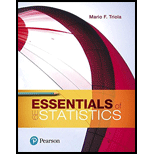
Concept explainers
Testing Claims About Proportions. In Exercises 7–22, test the given claim. Identify the null hypothesis, alternative hypothesis, test statistic, P-value or critical value(s), then state the conclusion about the null hypothesis, as well as the final conclusion that addresses the original claim.
20. Does Aspirin Prevent Heart Disease? In a trial designed to test the effectiveness of aspirin in preventing heart disease, 11,037 male physicians were treated with aspirin and 11,034 male physicians were given placebos. Among the subjects in the aspirin treatment group, 139 experienced myocardial infarctions (heart attacks). Among the subjects given placebos, 239 experienced myocardial infarctions (based on data from “Final Report on the Aspirin Component of the Ongoing Physicians’ Health Study,” New England Journal of Medicine, Vol. 321: 129-135). Use a 0.05 significance level to test the claim that aspirin has no effect on myocardial infarctions.
a. Test the claim using a hypothesis test.
b. Test the claim by constructing an appropriate confidence interval.
c. Based on the results, does aspirin appear to be effective?
Want to see the full answer?
Check out a sample textbook solution
Chapter 9 Solutions
Essentials of Statistics (6th Edition)
- What is an experiment? Give two examples.arrow_forwardWhat term is used to express the likelihood of an event occurring? Are there restrictions on its values? If so, what are they? If not, explain.arrow_forwardWhat is the difference between events and outcomes? Give an example of both using the sample space of tossing a coin 50 times.arrow_forward
- What is an experiment?arrow_forwardWhat is meant by the sample space of an experiment?arrow_forwardPCB contamination of a river by a manufacturer is being measured by amounts of the pollutant found in fish. A company scientist claims that the fish contain only 5 parts per million, but an investigator believes the true figure is higher. What is the conclusion if six fish are caught and show the following amounts of PCB ( in parts per million ) 6.8, 5.6, 5.2, 4.7, 6.3, and 5.4? Test at 5% significance level. In addition to your conclusions, you must provide the null and alternative hypothesis , alpha and the p-value.arrow_forward
- According to a report on consumer fraud and identity theft, 22% of all complaints for a year were for identity theft. In that year, Ohio had 825 complaints of identity theft out of 3452 consumer complaints. Does this data provide enough evidence to show that Ohio had a higher proportion of identity theft than 22%? Test at the 1% level. State the hypotheses. Ho: p? v Ha: p|? v Calculate the test statistic. Round to four decimal places. Calculate the standardized test statistic. Round to three decimal places. Z = Find the p-value. Round to four decimal places. p-value State your decision. O Since the p-value is greater than .01, fail to reject Ho. O Since the p-value is less than .01, fail to reject Ho. O Since the p-value is less than .01, reject Họ. O Since the p-value is greater than .01, reject Ho. Interpret the results. O At the 1% level of significance, there is not enough evidence to show that the proportion of complaints due to identity theft in Ohio is not equal to 22%. O At the…arrow_forwardTesting Claims About Proportions. In Exercises 7–22, test the given claim. Identify the null hypothesis, alternative hypothesis, test statistic, P-value or critical value(s), then state the conclusion about the null hypothesis, as well as the final conclusion that addresses the original claim. License Plate Laws The Chapter Problem involved passenger cars in Connecticut and passenger cars in New York, but here we consider passenger cars and commercial trucks. Among 2049 Connecticut passenger cars, 239 had only rear license plates. Among 334 Connecticut trucks, 45 had only rear license plates (based on samples collected by the author). A reasonable hypothesis is that passenger car owners violate license plate laws at a higher rate than owners of commercial trucks. Use a 0.05 significance level to test that hypothesis. a. Test the claim using a hypothesis test. b. Test the claim by constructing an appropriate confidence interval.arrow_forwardTen individuals went on a low-fat diet for 12 weeks to lower their cholesterol. The data are recorded in the table below. Do you think that their cholesterol levels were significantly lowered? Conduct a hypothesis test at the 5% level. Starting cholesterol level Ending cholesterol level 140 140 200 230 110 130 240 220 200 190 180 150 190 200 360 300 280 300 260 240 a. State the null hypothesis. b What is the test statistic?arrow_forward
- Activity in Statistics please solve & explain your answerarrow_forwardhypothesis testing is the topicarrow_forwardExplain the statement: "The strength of a conclusion is based on the quality of evidence used to support the conclusion." Use examples in your explanation. Are there cases when a small sample can provide sufficient research data? Explain your answer. How does a sample from a controlled study differ from a sample from a poll? Use an example of each in your explanationarrow_forward
 Big Ideas Math A Bridge To Success Algebra 1: Stu...AlgebraISBN:9781680331141Author:HOUGHTON MIFFLIN HARCOURTPublisher:Houghton Mifflin Harcourt
Big Ideas Math A Bridge To Success Algebra 1: Stu...AlgebraISBN:9781680331141Author:HOUGHTON MIFFLIN HARCOURTPublisher:Houghton Mifflin Harcourt
 Glencoe Algebra 1, Student Edition, 9780079039897...AlgebraISBN:9780079039897Author:CarterPublisher:McGraw Hill
Glencoe Algebra 1, Student Edition, 9780079039897...AlgebraISBN:9780079039897Author:CarterPublisher:McGraw Hill Holt Mcdougal Larson Pre-algebra: Student Edition...AlgebraISBN:9780547587776Author:HOLT MCDOUGALPublisher:HOLT MCDOUGAL
Holt Mcdougal Larson Pre-algebra: Student Edition...AlgebraISBN:9780547587776Author:HOLT MCDOUGALPublisher:HOLT MCDOUGAL College Algebra (MindTap Course List)AlgebraISBN:9781305652231Author:R. David Gustafson, Jeff HughesPublisher:Cengage Learning
College Algebra (MindTap Course List)AlgebraISBN:9781305652231Author:R. David Gustafson, Jeff HughesPublisher:Cengage Learning




